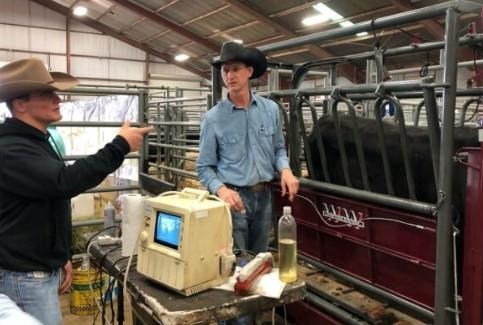By Sarah Boden
This winter has thrown Mercer County farmer Johnny Parker for a loop. After a bitterly cold November and December, Parker, the operations manager at Edible Earth Farms, was anticipating a long winter.
But January and February have seen multiple days when temperatures reached past 50 or even 60 degrees. Many perennials, including chives and rhubarb, are already coming out of the ground.
Parker has kept detailed records of weather patterns throughout the seasons, so he knows when to harvest his tomatoes, how deep to plant sweetcorn, or when to uncover the green beans for spring pollination. Yet, in his 14 years at Edible Earth, he’s never experienced a season like this winter.
“I’m not entirely sure how to plan,” said Parker, “and a lot of planning goes into the production side of things in the next two months.”

Edible Earth Farm founder April Parker (right) and farm operations manager Johnny Parker in one of their greenhouses.
Freezing temperatures returned to Mercer County over the weekend, but more temperate weather is again forecast for later this week — low 50s are predicted for Wednesday.
It’s not been all bad — Parker is spending less money to heat his greenhouses. But he’s concerned that if the yo-yoing continues, his plants will bloom too soon. He’s especially worried his strawberry plants will start to flower early, only to be killed off by another dramatic drop.
Fruit trees are perhaps the most vulnerable to these extreme temperature swings. If a cold snap happens too soon after a tree starts to bloom, it can damage its flowers and buds. This happened to some fruit producers last year, says Bob Pollock of Penn State Extension in Indiana County. But the weather up to now hasn’t presented a threat.
“We haven’t had a stretch of really warm weather … we still mostly have cooled off at night, so that’s to our advantage,” said Pollock. But if there are several days in a row that temperatures are in the 70s before another cold snap, fruit crops could suffer.
Over in Cambria County, Marty Yahner has been enjoying the warm weather on the farm that his great-great-great grandfather started after immigrating from Germany to Pennsylvania in 1829. When it’s not so cold, Yahner’s black Angus cattle can gain more weight while eating less; also he’s gotten a jump on spring field work like spreading fertilizer. Later this season, he’ll plant oats, corn and soybeans.
“The only good thing about snow is that it protects the winter wheat from freezing and thawing,” said Yahner, who sits on the Pennsylvania Farm Bureau’s board of directors. “The only other good thing about snow is you can track deer when we’re hunting them.”
Click here to see more...